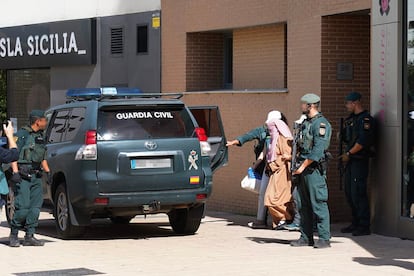The metamorphosis of jihadism in Spain
The current Islamist threat includes more women, more minors and variations in the sociological profile of terrorists compared to 2004


Spain has changed in the last two decades. So has the jihadist threat. Ever since 10 backpack bombs exploded on four Madrid commuter trains on March 11, 2004, killing 192 people and wounding nearly 2,000, security forces have carried out more than 400 operations against Islamist terrorism and arrested 1,049 suspected jihadists. The last arrest took place last Wednesday in Melilla, an exclave city on the northern coast of Africa. But the background of the detainees has been evolving over the years. Seven factors explain the changes.
From Al Qaida to ISIS. Fernando Reinares, a professor at Rey Juan Carlos University, associate researcher at the Elcano Royal Institute think tank and author of several books on the March 11 bombings, emphasizes that the terrorist structure that committed the Madrid attacks “had a direct connection with the command of Al Qaida,” then the hegemonic jihadist organization. Two decades later, the spotlight has been taken over by the self-proclaimed Islamic State (ISIS). The members of a terrorist cell responsible for the attacks in Barcelona and Cambrils in 2017 had ties in Belgium to the foreign security apparatus of this latter group. In the last decade, more than 95% of the jihadists detected in Spain followed the tenets of ISIS, according to police estimates. However, experts in the fight against terrorism admit that sometimes these loyalties are confusing: “Cases of terrorists who consume and spread propaganda from different and even disparate organizations are not uncommon.”
Gaza. Civil Guard General Manuel Navarrete, director of the Intelligence Center against Terrorism and Organized Crime (CITCO), which answers to the Interior Ministry, highlights changes in the jihadist propaganda spread on the internet: “In its heyday, ISIS used its terrorist attacks to attract new followers, but now that they commit fewer attacks they use other decoys.” For instance? “During the pandemic it was Covid, presented as a religious curse. Today, it is the burning of Korans in Sweden and Denmark, and the war in Gaza.” Navarrete adds that this latest conflict “has been instrumentalized by the jihadists to turn it into a war of religion” despite the fact that Hamas [the Palestinian organization that carried out the October 7 attacks in Israel] has a much more nationalist than religious component.
From immigrants to Spain-born terrorists. For Reinares, “the main transformation” in these 20 years is in the background of the terrorists. As in other European countries, they are still predominantly men, although they are increasingly getting younger. However, the substantial difference in Spain is that “this terrorism has stopped being carried out by first-generation immigrants and is instead carried out by their children, young people who have been born or raised in Spain.” And he provides an example: “Of the 26 individuals who made up the network that committed the 11-M attacks, all but one [Rachid Aglif, who arrived in Spain when he was 14] were first-generation immigrants. In the Ripoll cell, in 2017, it was the other way around: only one [imam Abdelbaki Es Satty] could be considered a first-generation immigrant. The rest were born, raised or socialized in Spain.”
The risk of returnees. The conflicts in Syria and Iraq added the figure of Foreign Terrorist Fighters (FTC) to the threat. CITCO specialists highlight that when they return to their countries of origin their danger is twofold: “They have experience in handling weapons and explosives and, in addition, they are seen as heroes, which makes them powerful instruments of radicalization.” Other police sources also warn about “frustrated” combatants, that is, those who tried unsuccessfully to reach territories controlled by ISIS and who, after failure, may attempt attacks in their places of residence. CITCO statistics reflect that 272 jihadists have left Spain since 2015 to move to conflict zones (a relatively low figure compared to other countries such as France, with nearly 2,000; Germany, more than a thousand, or Belgium, more than 500). Of these, at least 65 have returned to Europe and, out of the rest, just over 100 have died while a similar number remain in a conflict zone (mainly Syria or Iraq).
More women. “The Abu Dandah cell [dismantled by the Spanish police in 2001 for its relationship with the 9/11 attacks] literally relegated the women to the kitchen when they met. These days they play a more active role,” says a veteran police officer with experience in the fight against terrorism. General Navarrete agrees: “It is true that women are acquiring an increasingly leading role. Although in Spain the majority is occupied with logistical support, recruitment or financing, in other countries plans for attacks have already been intercepted.” According to a study by the Elcano Royal Institute, between 2001 and 2011 there were no women arrested in Spain for jihadist activities. Today they represent about 12% of arrests.
More minors. Last year eight minors were arrested for jihadist activities, according to the CITCO. Three of them had manuals for making explosives and plans to attack an “apostate.” So far in 2024, another minor who was completing a homemade explosive device has been arrested. “Jihadist propaganda is increasingly directed at minors,” says General Navarrete, who adds that they are recruited on online gaming platforms and on social networks. Jihadist versions of war games such as the popular Call of Duty have also been detected. The Elcano Royal Institute points out that those who began their radicalization when they were not yet of legal age have gone from representing 17.1% of those convicted or deceased in Spain between 2001 and 2011, to 23.4% between 2012 and 2023.
The prisons. At the end of February there were 81 prisoners in Spanish penitentiaries accused of jihadist terrorism. Added to these are the 38 inmates who entered prison for other crimes but have become radicalized inside, and 59 more inmates who show signs of following the same steps, according to data from penitentiary authorities. According to the Elcano Royal Institute, 10.5% of the jihadists convicted or killed in Spain to October 2018 and who were totally or partially radicalized in Spain, acquired these radical views in prison. At the end of last year, penitentiary authorities launched a new reintegration plan to which 17 jihadist inmates have signed up. A CITCO member emphasizes that recidivism is “low.” So far, seven prisoners who served time for jihadism in Spain have returned to prison for committing crimes. And, of these, two were for other crimes unrelated to jihadism.
Sign up for our weekly newsletter to get more English-language news coverage from EL PAÍS USA Edition
Tu suscripción se está usando en otro dispositivo
¿Quieres añadir otro usuario a tu suscripción?
Si continúas leyendo en este dispositivo, no se podrá leer en el otro.
FlechaTu suscripción se está usando en otro dispositivo y solo puedes acceder a EL PAÍS desde un dispositivo a la vez.
Si quieres compartir tu cuenta, cambia tu suscripción a la modalidad Premium, así podrás añadir otro usuario. Cada uno accederá con su propia cuenta de email, lo que os permitirá personalizar vuestra experiencia en EL PAÍS.
¿Tienes una suscripción de empresa? Accede aquí para contratar más cuentas.
En el caso de no saber quién está usando tu cuenta, te recomendamos cambiar tu contraseña aquí.
Si decides continuar compartiendo tu cuenta, este mensaje se mostrará en tu dispositivo y en el de la otra persona que está usando tu cuenta de forma indefinida, afectando a tu experiencia de lectura. Puedes consultar aquí los términos y condiciones de la suscripción digital.
More information
Últimas noticias
Maduro pleads not guilty before the federal court in New York: ‘I am still the president of Venezuela’
A new test can detect Alzheimer’s from a finger prick
UN team enters Sudanese city of El Fasher after paramilitary massacre: ‘It’s like a ghost town’
A recipe for resistance: Indigenous peoples politicize their struggles from the kitchen
Most viewed
- Gilles Lipovetsky: ‘If you want to live better and fall in love, take Prozac, don’t look to philosophy’
- Alain Aspect, Nobel laureate in physics: ‘Einstein was so smart that he would have had to recognize quantum entanglement’
- Alvin Hellerstein, a 92-year-old judge appointed by Bill Clinton, to preside over Maduro’s trial in New York
- Why oil has been at the center of Venezuela-US conflicts for decades
- Maduro’s downfall puts China’s relationship with Venezuela to the test










































